Introduction to the Recipe
If you’ve ever savored the pillowy softness of freshly steamed bao buns at a restaurant, you know how irresistible these little pockets of delight can be. Making your own homemade bao buns recipe is a rewarding and surprisingly simple culinary adventure that brings a taste of authentic Asian cuisine right to your kitchen. These fluffy, slightly sweet buns are perfect for wrapping around savory fillings like braised pork belly, crispy tofu, or flavorful mushrooms, making them an incredibly versatile dish.
The magic of bao buns lies in their delicate texture, achieved through a combination of key ingredients such as all-purpose flour, baking powder, and instant yeast. Adding cultured buttermilk or Greek yogurt to the dough not only tenderizes it but also adds a subtle tang that enhances the flavor profile. Warm water helps activate the yeast, ensuring a good rise, while a touch of sugar fuels fermentation, resulting in that classic, airy softness.
If you’re new to bao buns or looking to improve your technique, exploring tips on how to activate yeast properly can be incredibly helpful. Additionally, understanding the differences between baking powder and yeast can enhance your grasp of what each ingredient contributes to the dough’s texture.
Whether you’re planning a weekend cooking project or want to impress guests with homemade Asian-inspired dishes, this homemade bao buns recipe is your go-to guide for soft, fluffy, and delicious buns that melt in your mouth. From the basics of mixing the dough to mastering the steaming process, this article covers everything you need to know to create perfect bao buns at home.
Basic Recipe: Ingredients and Instructions
Print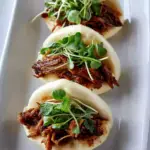
Homemade Bao Buns Recipe
Description
Light, fluffy Homemade Bao Buns made with simple ingredients—perfect for stuffing, steaming, and enjoying fresh from the steamer.
Ingredients
- 3 ½ cups all‑purpose flour (≈ 12 ¾ ounces by weight)
- 1 tablespoon granulated sugar
- 1 teaspoon baking powder
- ½ teaspoon kosher salt
- 1 teaspoon instant yeast
- 1 cup warm water (around 38‑40 °C / 100‑105 °F)
- 2 tablespoons cultured buttermilk or Greek yogurt
- Canola or sunflower oil (for greasing and shaping)
- Non‑stick cooking spray or oil for the steamer/parchment
Instructions
- Mix dry ingredients.
In a large mixing bowl (or stand mixer bowl), combine the all‑purpose flour, sugar, baking powder, kosher salt, and instant yeast. Whisk or stir until evenly distributed. - Add wet ingredients.
In a separate bowl, whisk together the warm water and the buttermilk (or Greek yogurt) until smooth. Pour into the dry ingredients. Mix with a spoon until a shaggy dough forms. - Knead the dough.
If using a stand mixer, attach the dough hook and knead on low to medium speed for about 5 minutes, until the dough is smooth, elastic, and slightly tacky but not overly sticky. If kneading by hand, turn the dough out onto a lightly floured surface and knead similarly (7‑10 minutes), adding small amounts of flour only as needed so that the dough holds together but remains soft. - First proof (rise).
Lightly oil a clean bowl, placing the dough inside and turning it so all sides get a thin coating of oil. Cover with plastic wrap or a damp cloth. Let the dough rest in a warm, draft‑free place until it doubles in size—about 1 to 1½ hours, depending on ambient temperature. - Divide and shape.
Once risen, punch the dough down gently to release large air bubbles. Divide it into equal portions depending on how large you want each bun (e.g., 8‑12 buns). Roll each piece into a ball. Roll each ball into an oval or circle (depending on style). If making the folded bao style (i.e., the kind that opens like a pocket), lightly brush one side of the rolled piece with oil, fold it over (so the oiled side is inside), forming the “lip.” - Second proof.
Place the shaped buns on individual small squares of parchment paper or lightly oiled parchment. Cover loosely with a damp cloth or plastic wrap, and let proof again for 30‑60 minutes, until puffed. - Steam the buns.
Prepare a steamer (bamboo or metal) with boiling water. Reduce to medium heat so steam is steady but not overly rolling. Place buns (on their parchment squares) in the steamer, leaving space between them (they will expand). Steam for about 8‑12 minutes, depending on size. Do not open the lid during steaming, as this can cause collapse. - Rest and serve.
Once done, turn off heat and let the buns rest in the steamer for 2 minutes with lid closed. Then remove buns gently. Serve warm with your desired fillings. If you like, spray or brush with a little oil to give a slight sheen.
Notes
Using instant yeast helps reduce proofing time; make sure it’s fresh.
The warm water should not be too hot, as overly high temperatures can kill yeast.
Dough consistency: slightly tacky is good; overly sticky makes shaping hard, overly dry yields dense buns.
Proofing times vary with room temperature—if cool, proof longer; if warm, check earlier.
Use parchment paper under buns in steamer to prevent sticking; or lightly oil/parchment.
Keywords: Bao Buns
Advanced Techniques
Mastering the Dough Texture
To achieve the perfect bao bun texture, knead the dough until it’s very smooth and elastic, which develops the gluten structure. You can perform the “windowpane test” by stretching a small piece of dough thinly until light passes through without tearing. This ensures your dough is well-kneaded. Additionally, resting the dough properly during rising allows the yeast to produce gas bubbles, creating that airy fluffiness.
Using Rice Flour for Dusting
Instead of regular flour, try dusting your buns and work surface with rice flour during shaping and folding. Rice flour prevents sticking without absorbing moisture from the dough, keeping the buns softer and less dense than if dusted with all-purpose flour. This subtle switch makes a big difference in the final texture.
Folding Techniques for Shape
For a more refined look, experiment with different folding techniques such as pleating or twisting the bun edges before steaming. Pleating adds visual appeal and helps the buns hold fillings better. Practice with small amounts of dough first, and use a light touch to avoid deflating the dough.
Flavor Enhancements in the Dough
Adding subtle flavors to the dough can elevate your bao buns. For instance, infuse the water with a tea like jasmine or matcha before mixing, or incorporate a teaspoon of sesame oil for a nutty aroma. These additions add complexity without overpowering the mild sweetness of the buns.
Perfecting the Steaming Process
Maintaining consistent steam is crucial for bao buns. Avoid opening the steamer lid during cooking, as this causes temperature drops and uneven cooking. Use a bamboo steamer lined with parchment paper for best results, and place the steamer over boiling water with enough water to last the steaming duration.
See more advanced recipes at cookingwhite.com
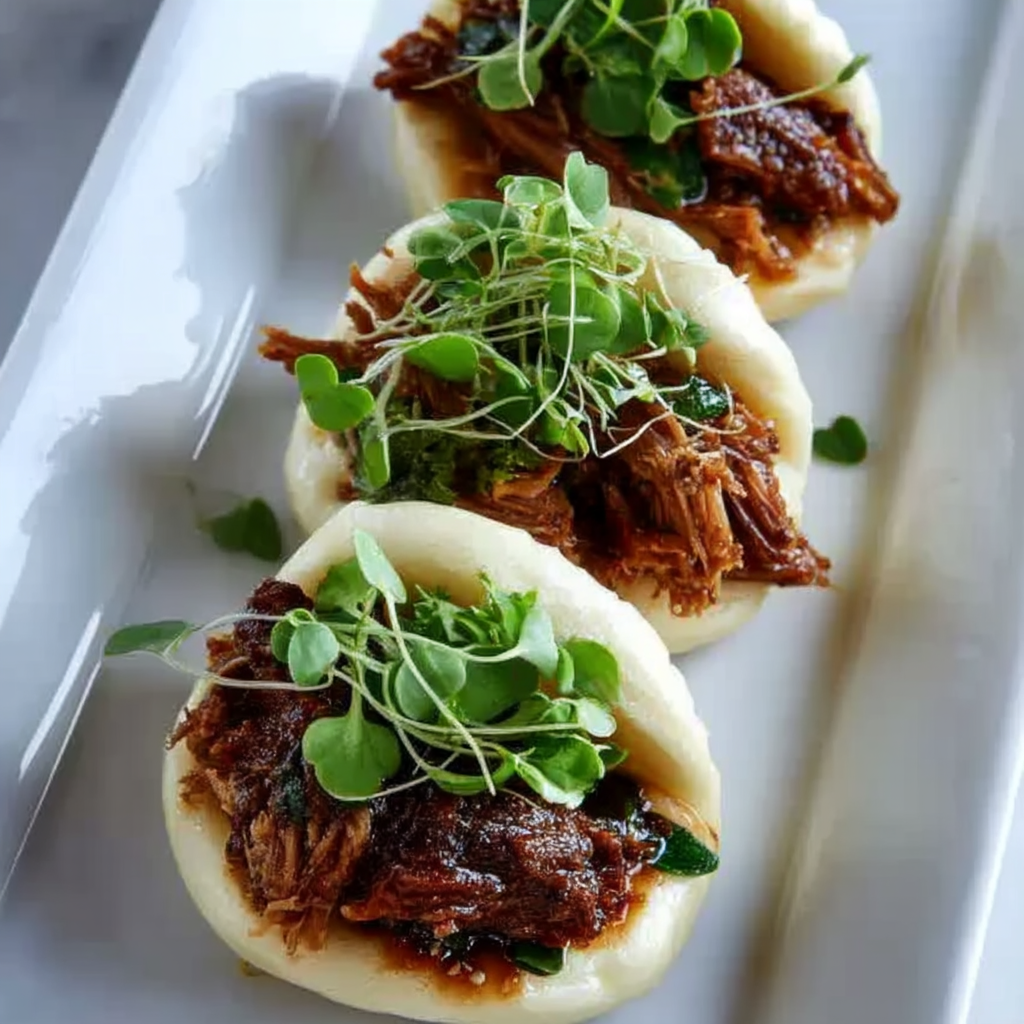
Storage, Shelf Life, and Maintenance Tips
Storing Fresh Bao Buns
Freshly steamed bao buns are best enjoyed immediately but can be stored at room temperature for up to 4 hours in an airtight container. To keep them soft, wrap them in a clean kitchen towel before placing in the container to retain moisture.
Refrigeration Tips
If you need to store bao buns longer, place them in an airtight container or zip-top bag and refrigerate for up to 2 days. Reheat by steaming again for 5-7 minutes to restore softness and warmth.
Freezing Bao Buns
Bao buns freeze beautifully. Wrap each bun tightly in plastic wrap or parchment paper, then place in a freezer-safe bag. Freeze for up to 1 month. To reheat, steam directly from frozen for 15-18 minutes without thawing.
Avoiding Sogginess When Storing
To prevent soggy buns during storage, avoid stacking them tightly. Use parchment paper between layers and ensure the storage container has some airflow. If sogginess occurs, re-steaming will help regain the texture.
Maintaining Steamer Hygiene
Keep your steamer clean and dry between uses to avoid off-flavors or mold. Remove any residue and allow it to air dry completely. Use fresh water each time and avoid mineral buildup by using filtered water if possible.
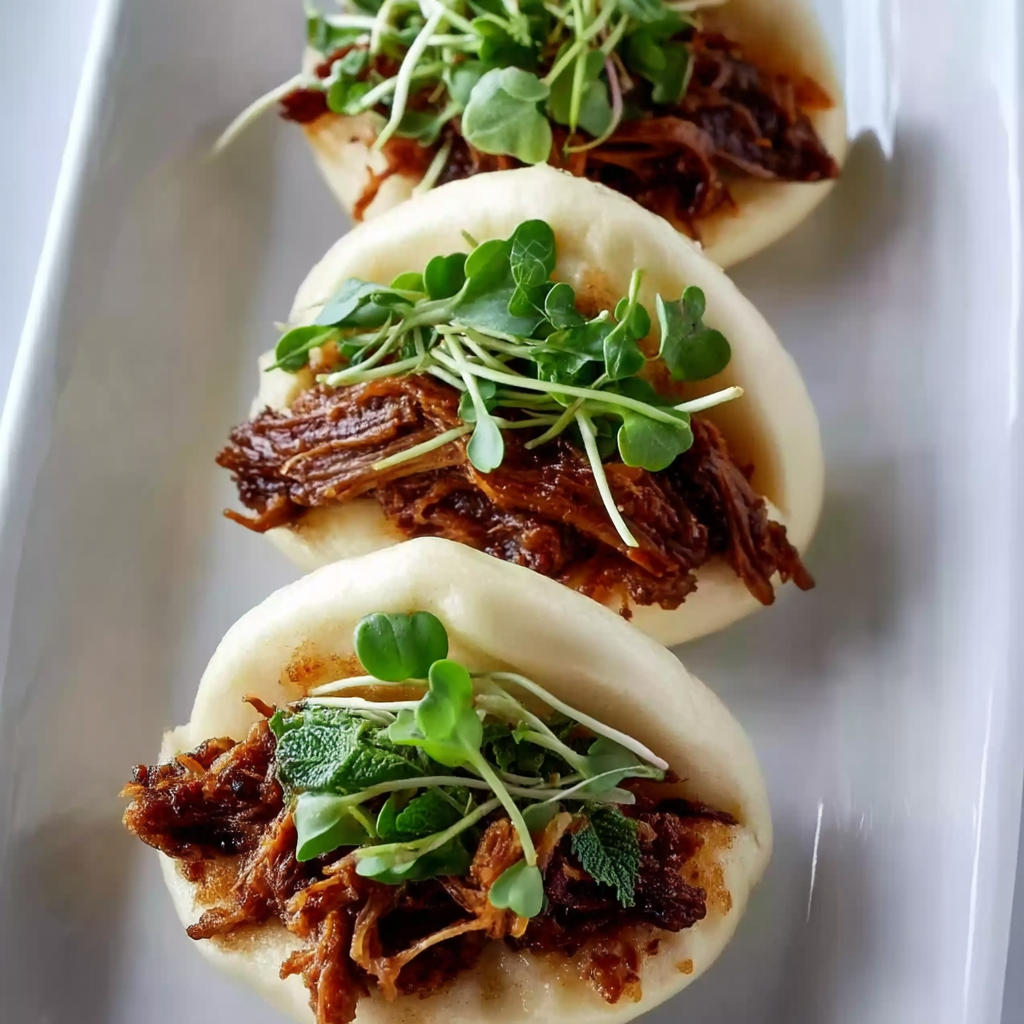
Dietary Adaptations and Substitutions
Vegan Adaptation
To make vegan bao buns, substitute cultured buttermilk or Greek yogurt with plant-based alternatives like almond yogurt or coconut milk mixed with a teaspoon of lemon juice. Ensure the sugar used is vegan-friendly, and replace canola oil with a neutral vegetable oil.
Gluten-Free Version
For gluten-free bao buns, replace all-purpose flour with a gluten-free flour blend that includes xanthan gum for elasticity. The texture will differ but can still be soft if steamed correctly. Experiment with blends designed for bread or dough to get the best results.
Low-Sugar Modification
Reduce the sugar to half a tablespoon or substitute with natural sweeteners like maple syrup or agave nectar to decrease sugar content while maintaining slight sweetness. This works well if you’re pairing buns with very sweet fillings.
Nut-Free Adjustments
This recipe is naturally nut-free, but if using any flavored oils or toppings, ensure they are nut-free to avoid allergens. Check your ingredients carefully if serving to someone with nut allergies.
Dairy-Free Option
Use dairy-free yogurt alternatives such as soy or coconut yogurt instead of cultured buttermilk or Greek yogurt. This keeps the dough moist and tender without dairy, suitable for lactose intolerance or dairy-free diets.
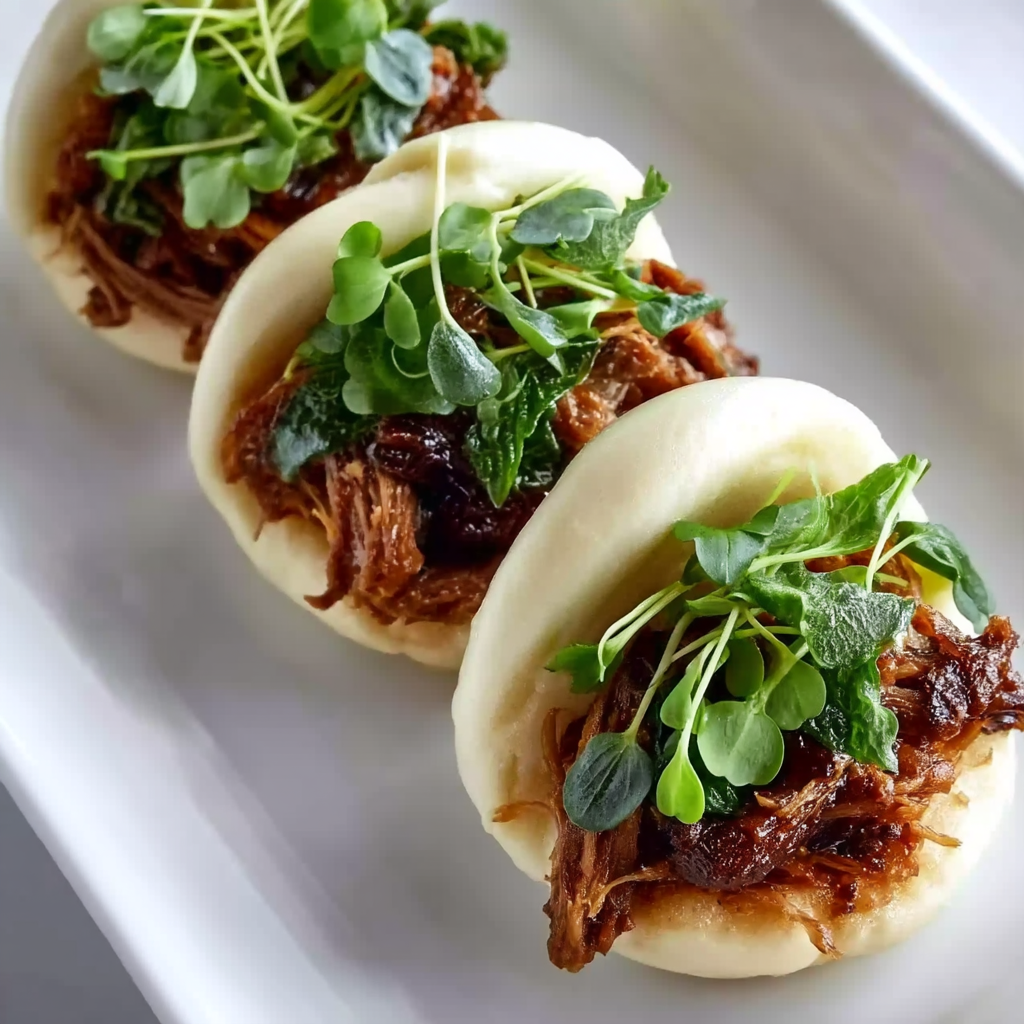
FAQs About the Recipe
Why Are My Bao Buns Dense Instead of Fluffy?
Dense buns often result from insufficient kneading or yeast not being properly activated. Make sure your yeast is fresh and the water temperature is warm but not hot. Knead the dough until elastic and allow ample rising time for the yeast to create air bubbles, which lighten the texture.
Can I Use Regular Milk Instead of Buttermilk or Yogurt?
While regular milk can be used, the acid in buttermilk or yogurt reacts with baking powder to create a tender crumb and slight tang. If using regular milk, add a teaspoon of vinegar or lemon juice to simulate the acidity and improve dough softness.
How Do I Prevent the Buns from Sticking to the Steamer?
Line your steamer with parchment paper or cabbage leaves to prevent sticking. Lightly spray or brush the liners with oil, and leave enough space between buns for expansion. Avoid overcrowding to allow even steam circulation.
Can I Bake Bao Buns Instead of Steaming?
Traditional bao buns are steamed for their signature soft texture, but they can be baked for a different experience. Baking results in a firmer, bread-like crust. If baking, preheat the oven to 350°F (175°C) and bake for 15-20 minutes or until golden.
How Long Can I Store the Dough Before Steaming?
After the first rise, the dough can be refrigerated for up to 24 hours. Bring it to room temperature before shaping and proceeding with the second rise. This slow fermentation can improve flavor but requires longer resting before steaming.
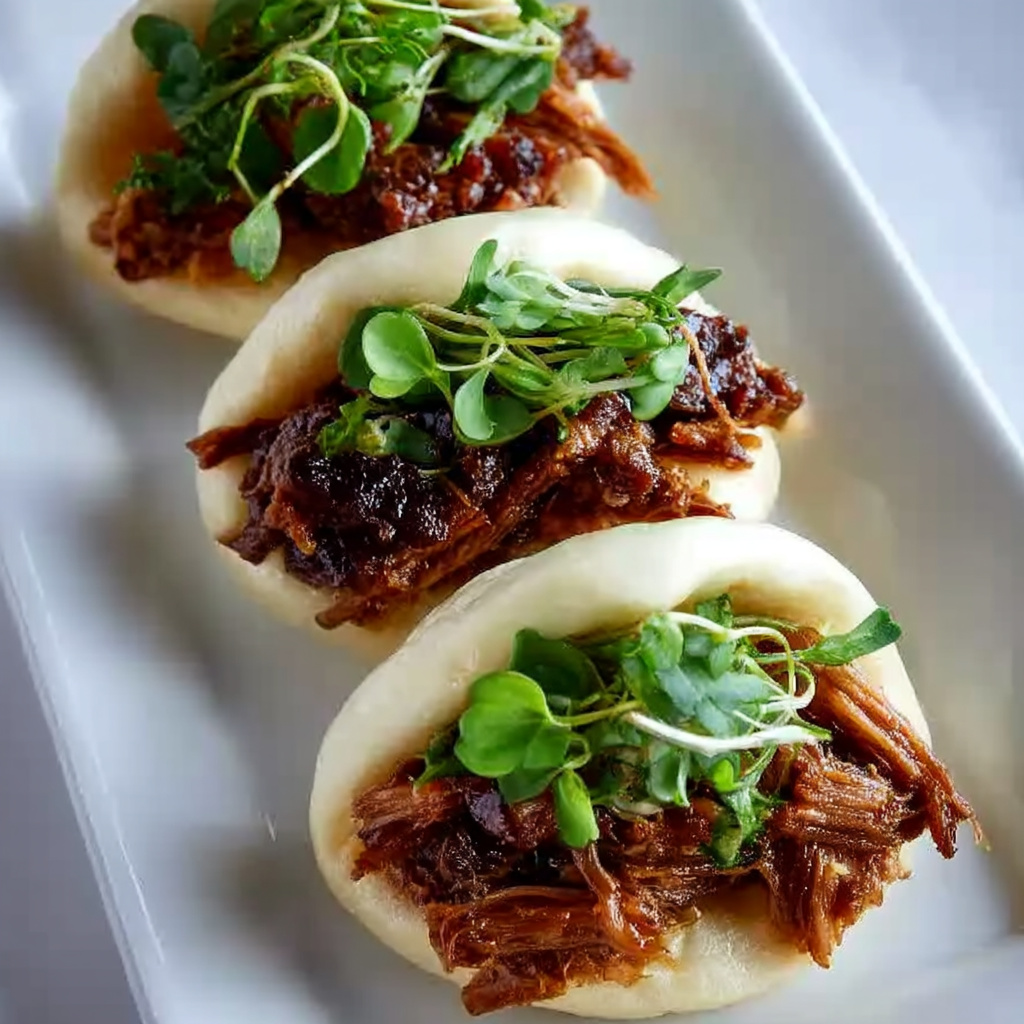
Conclusion & Final Thoughts
Making your own homemade bao buns recipe is a delightful way to experience traditional Asian cuisine in the comfort of your home. These soft, fluffy buns offer a versatile base for a wide array of fillings—from savory meats and vegetables to sweet treats—making them perfect for casual family dinners or special gatherings. The recipe’s simple ingredients belie the complexity of flavors and textures achieved through proper kneading, resting, and steaming techniques.
By mastering the basic dough and exploring advanced techniques, you can tailor your bao buns to your personal taste and style. Whether experimenting with flavors in the dough, adjusting dietary preferences, or perfecting your steaming setup, the journey to the perfect bao bun is both fun and satisfying.
Bao buns also bring a touch of cultural authenticity and warmth to your meals, making them a great conversation starter and a way to share a delicious culinary tradition with friends and family. With their tender crumb and subtle sweetness, these buns are sure to become a favorite staple in your recipe collection.
So, roll up your sleeves, grab your ingredients, and enjoy the process of crafting these fluffy little treasures. The joy of biting into a fresh, homemade bao bun filled with your favorite ingredients is truly unmatched—a culinary win that’s well worth the effort.
